1、光模块种类
| GBIC |  |
| XFP |  |
| 1X9 | 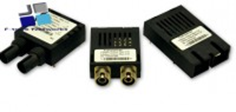 |
| SFF 2X5 | 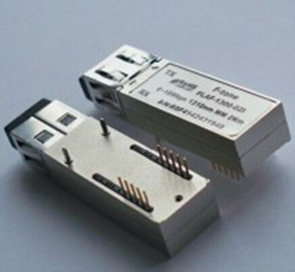 |
| SFF 2X10 | 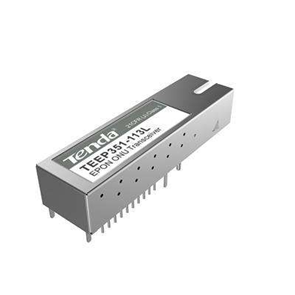 |
| SFP/SFP+/SFP28 | 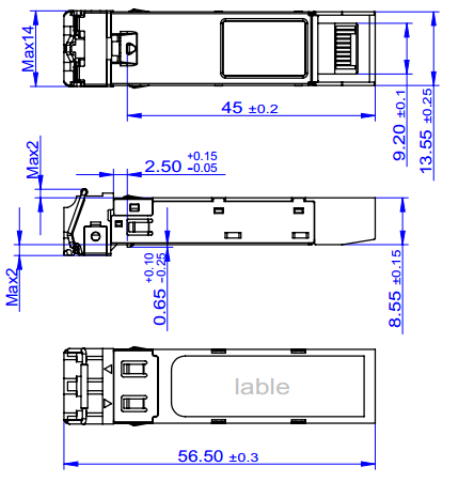 |
| QSFP | 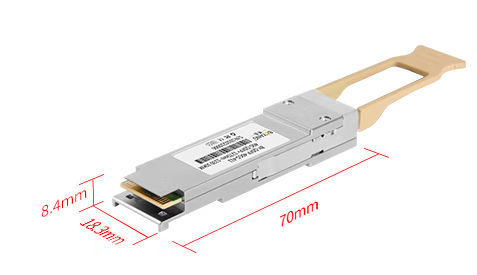 |
1.1、单纤光模块
单纤光模块只能型号A和型号B配套使用,如下图T1550/R1330和T1330/R1550配套。
单纤光模块TXRX的波长肯定是不同的。
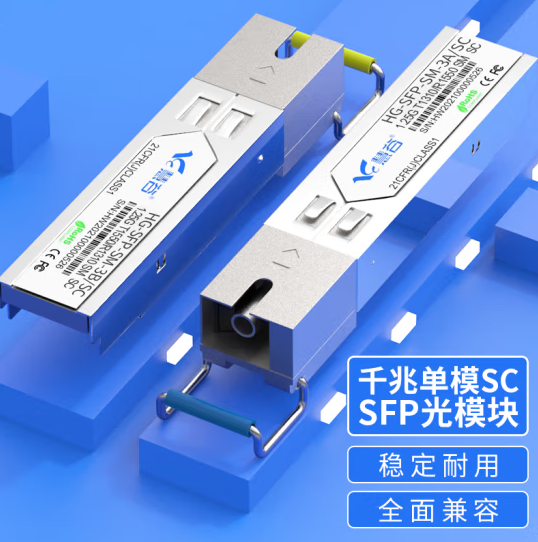
1.2、双纤光模块(最常见)
双纤光模块是则是有两个端口,TX为发射端口,RX为接收端口。发射和接收各需要一根光纤。
光模块外壳上的两个小三角表示TXRX方向(TOSA、ROSA)。

1.3、为什么是850/1310/1550nm波长
通过不断研究实验,人们发现光纤损耗通常随波长加长而减小,850nm损耗较少,900 ~ 1300nm损耗又变高了;而1310nm又变低, 1550nm损耗最低,1650nm以上的损耗趋向加大。所以850nm就是所谓的短波长窗口,1310nm 和1550nm就是长波长窗口。
因为850nm波长损耗较大,所以传输距离相对也较短。

2、管脚定义
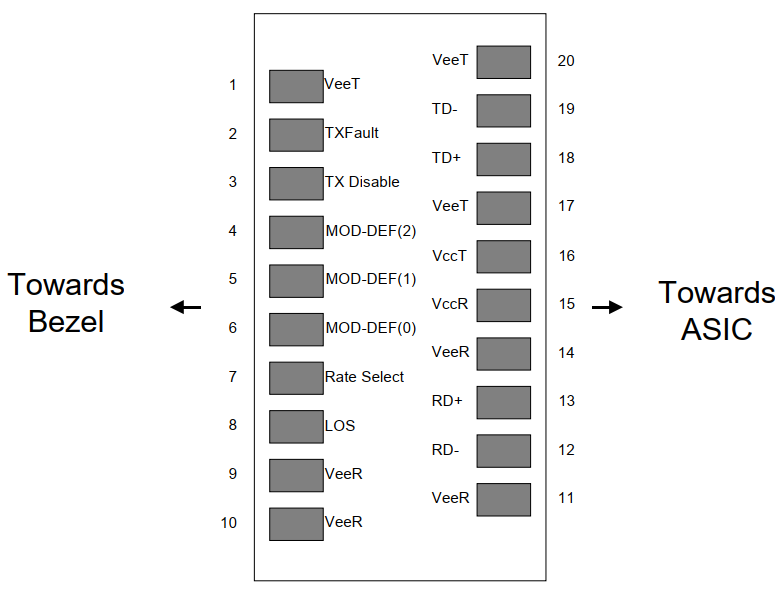
Signal Name |
Description |
Plug Seq |
Signal Name |
Description |
Plug Seq |
|
Pin |
SFP |
SFP+ |
||||
1 |
VeeT |
Transmitter Ground |
1 |
VeeT |
Transmitter Ground |
1 |
2 |
TX Fault |
Transmitter Fault Indication |
3 |
TX Fault |
Transmitter Fault Indication |
3 |
3 |
TX Disable |
Transmitter Disable |
3 |
TX Disable |
Transmitter Disable |
3 |
4 |
MOD_DEF(2) |
SDA |
3 |
MOD_DEF(2) |
SDA |
3 |
5 |
MOD_DEF(1) |
SCL |
3 |
MOD_DEF(1) |
SCL |
3 |
6 |
MOD_DEF(0) |
Module Present |
3 |
MOD_DEF(0) |
Module Present |
3 |
7 |
Rate Select |
Not Connect |
3 |
Rate Select 0 |
Rate Select 0, optionally controls SFP+ module receiver |
3 |
8 |
LOS |
Loss of Signal |
3 |
LOS |
Loss of Signal |
3 |
9 |
VeeR |
Receiver ground |
1 |
Rate Select 1 |
Rate Select 1, optionally controls SFP+ module transmitter |
1 |
10 |
VeeR |
Receiver ground |
1 |
VeeR |
Receiver ground |
1 |
11 |
VeeR |
Receiver ground |
1 |
VeeR |
Receiver ground |
1 |
12 |
RD- |
Inv. Received Data Out |
3 |
RD- |
Inv. Received Data Out |
3 |
13 |
RD+ |
Received Data Out |
3 |
RD+ |
Received Data Out |
3 |
14 |
VeeR |
Receiver ground |
1 |
VeeR |
Receiver ground |
1 |
15 |
VccR |
Receiver Power Supply,3.3V ± 5% |
2 |
VccR |
Receiver Power Supply,3.3V ± 5% |
2 |
16 |
VccT |
Transmitter Power Supply,3.3V ± 5% |
2 |
VccT |
Transmitter Power Supply,3.3V ± 5% |
2 |
17 |
VeeT |
Transmitter Ground |
1 |
VeeT |
Transmitter Ground |
1 |
18 |
TD+ |
Transmit Data In |
3 |
TD+ |
Transmit Data In |
3 |
19 |
TD- |
Inv. Transmit Data In |
3 |
TD- |
Inv. Transmit Data In |
3 |
20 |
VeeT |
Transmitter Ground |
1 |
VeeT |
Transmitter Ground |
1 |
Power(VeeT、VeeR、VccT、VccR)
Power Sequence(Plug Sequence)的Order_1是GND,包括VeeT(PIN1、17、20)和VeeR(PIN10、11、14,可能有PIN9);Order_2是Power,包括VccR(PIN15)和VccT(PIN16);Order_3是signal。在光模块的实物上(Layout),Order_1是最长的,最早与SPF笼子的座子接触,Order_2是次长的,Order_3是最短的,如下图。
TX Fault
对于光模块来说是output管脚,Low:normal,High:abnormal。
这个管脚是开漏(OD)或者是开集(OC)的,需要4.7k~10k Ohm的电阻上拉到Vcc,一般选择4.7K上拉到VccT。
TX Disable
对于光模块来说是input管脚,Low (0 to 0.8V):Transmitter on,(>0.8V, < 2.0V):Undefined,High (2.0 to 3.465V):Transmitter Disabled,Open:Transmitter Disabled。
这个管脚需要4.7k~10k Ohm的电阻上拉到Vcc,一般选择4.7K上拉到VccT(实际应用推荐200Ω上拉!)。
MOD_DEF2(SDA)、MOD_DEF1(SCL)
I2C slave接口
这两个管脚需要4.7k~10k Ohm的电阻上拉到Vcc,一般选择4.7K上拉到VccT。
MOD_DEF0(Module Absent)
有时候也会称作Module Present或Module Exist等。
对于光模块来说是output管脚,Low: 有光模块,High: 无光模块。
电路上,这个管脚需要4.7k~10k Ohm的电阻上拉到Vcc,一般选择4.7K上拉到VccT。
光模块本身,这个管脚是直连光模块GND的。
Rate Select
SFP的PIN7是NC的,SFP+的PIN7和PIN9是可选的。
Rate Select 0,Optionally controls SFP+ module receiver ,
High:RX output signaling rate>4.25GBd,Low:RX output signaling rate≤4.25GBd。
Rate Select 1,Optionally controls SFP+ module transmitter,
High:Tx input signaling rate>4.25GBd,Low:Tx input signaling rate≤4.25GBd。
LOS(Loss of Signal)
对于光模块来说是output管脚,Low:normal,High:loss signal。
这个管脚需要4.7k~10k Ohm的电阻上拉到Vcc,一般选择4.7K上拉到VccT。
Serdes
一般光模块都内置了AC Coupling电容(0.1uF),实际应用中一般还是会在PCB上留有0.1uF的AC Coupling电容,分别靠近IC和光模块的Output端。
1G/2.5G光模块一般为LVPECL电平,10G以上一般为CML电平。
3、原理图和Layout
3.1、MSA推荐
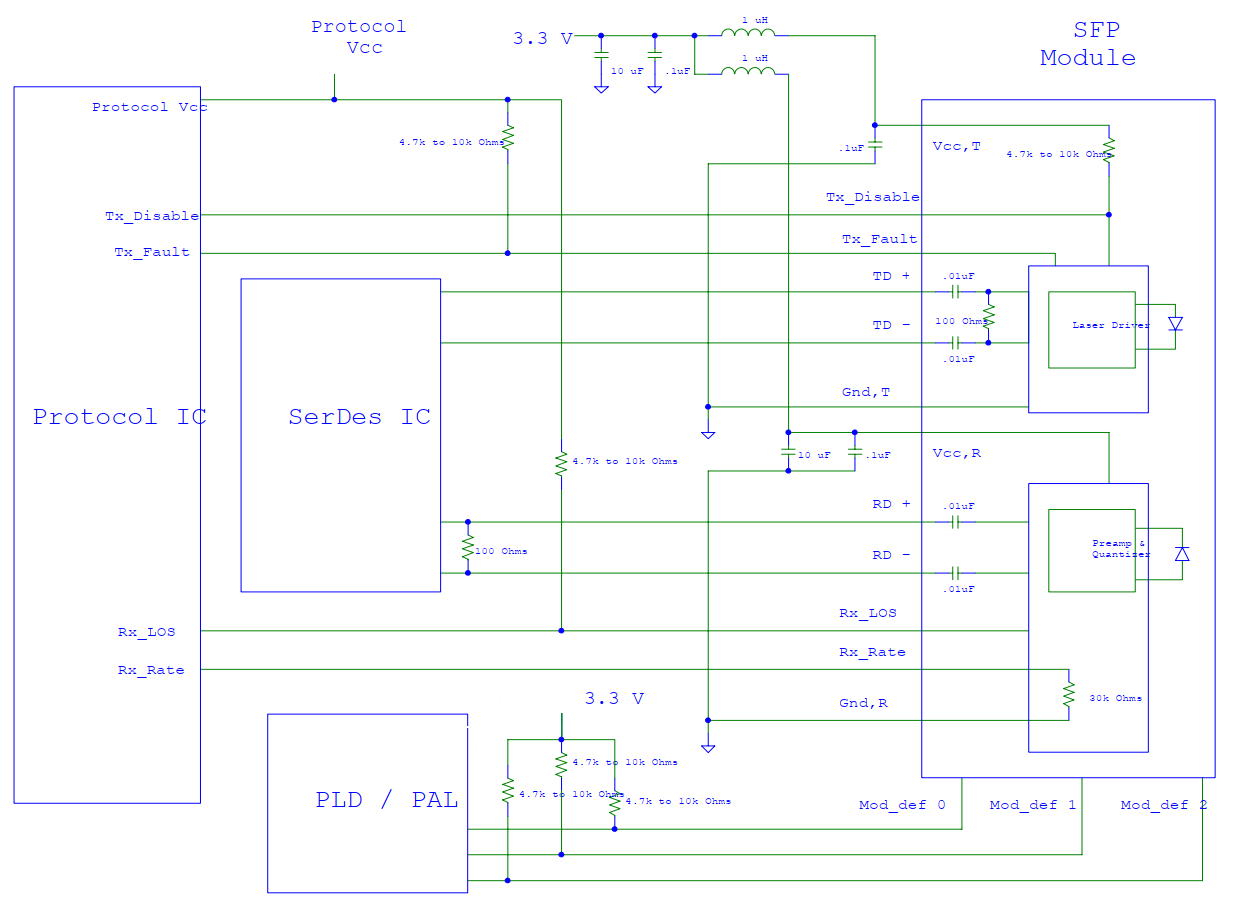
3.2、一般应用
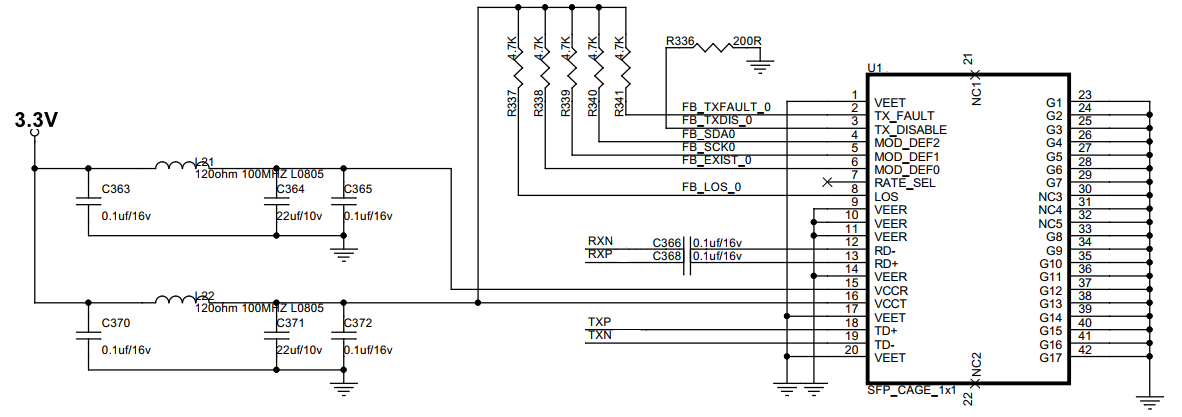
4、技术参数
4.1、光发射
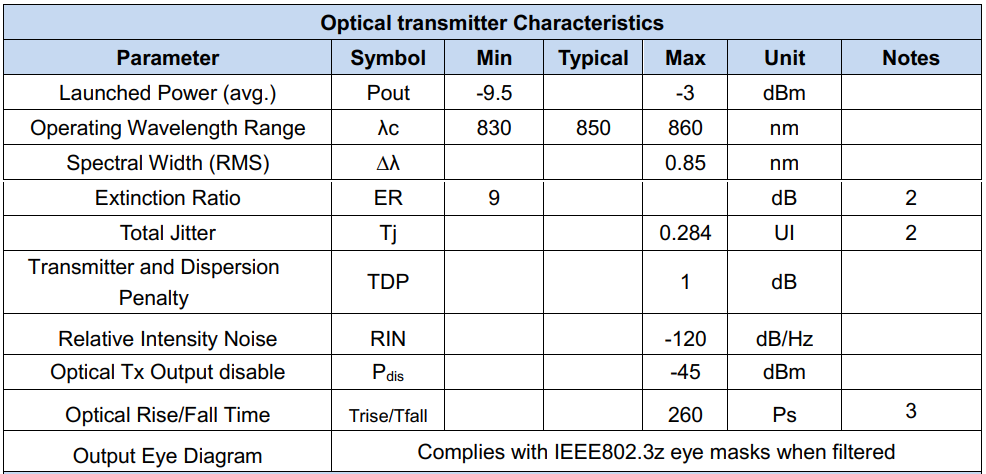
发射功率(Launched Power)
1000Base-SX:-9.5~hazard Level1
1000Base-LX:-11~-3dBm
10GBase-S:-7.3~ hazard Level1
10GBase-L:-8.2~0.5
10GBase-E:-4.7~4.0
消光比(Extinction ratio)
激光器在发射全“1”码时的光功率P1与全“0”码时发射的光功率P0之比。光源的消光比将直接影响接收机的灵敏度,为了不使接收机的灵敏度明显下降,消光比一般应大于3.5dB。测量方法参见IEEE802.3 38.6.3。
相对强度噪声(Relative Intensity Noise)
上升沿/下降沿时间(Optical Rise/Fall Time)
色散代价(Transmitter and Dispersion Penalty)
4.2、光接收
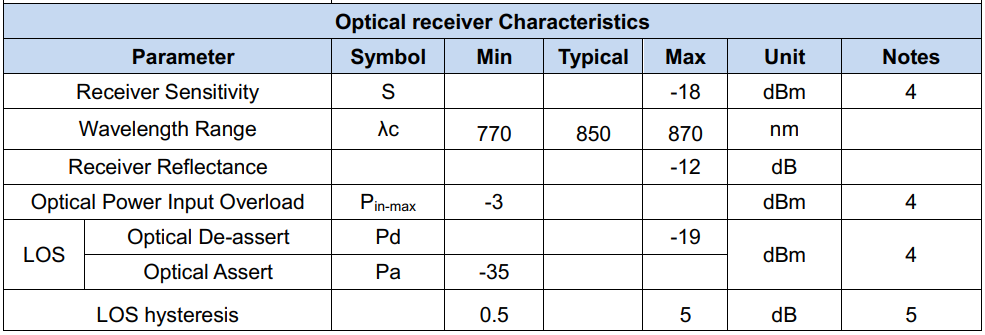
4.3、电气特性
5、DDM(Digital Diagnostic Monitor)
在SFF-8472中规定:

Serial ID(A0h)每个光模块都会有;DDM(A2h)则不是每个光模块都会有。